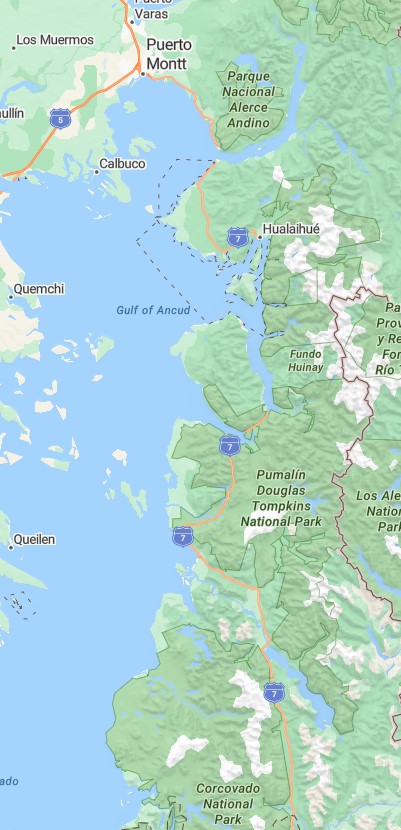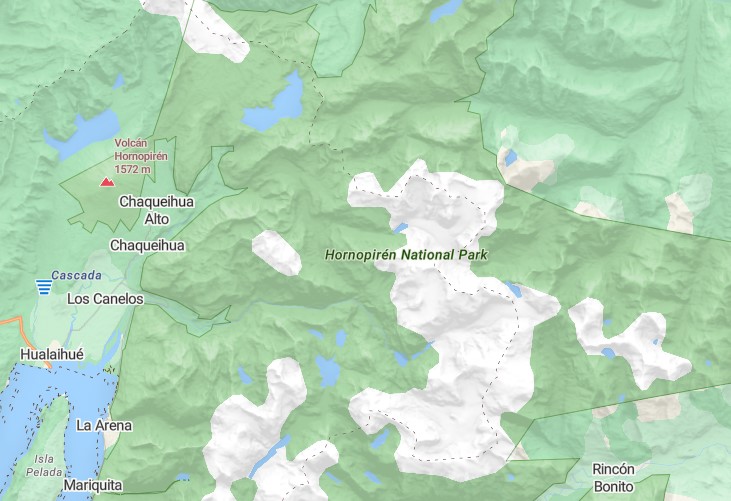The second park on our route through Chile’s national Patagonian parks takes us to the wild and mystical Hornopirén.
We are working our way south from Puerto Montt as our starting base, and have first traveled to the Alerce Andino National Park in our previous chapter.
If you haven’t yet read up on some of the foundations of the entire seventeen-park route, go back and check out my overview post so you can get oriented.
Hikers seek out Hornopirén park for its omnipresent volcanic peaks of Hornopirén and Yates, both providing a dramatic backdrop for several trails throughout the evergreen forests.
A second and important reason to visit is that this park is home to several unique species, making it a magnet for biologists, botanists, and scientists.
If you’re not visiting another part of Chile before starting on your Patagonian parks adventure, you will likely want to plan a flight to the closest hub, which is Puerto Montt, which is served by major airlines.
In Puerto Montt, you can also reserve airport transfers to pick you up and take you to your hotel or to the bus station.
Not every park requires an admission fee, but many do, and these generally range between $2 and $12 USD per person.
There are three ways to pay your fee:
You can register your visit and pay the entrance fee at the visitor information center or guard post at the park entrance. You don’t receive a permit in the formal sense of a bureaucratic document. It is a simpler and kinder process of just being recorded in the guest book of the park so the rangers know of your presence and when you plan to return.
The easiest solution is a handy online system at https://aspticket.cl, where you can both pay your admission fee and register in advance, and get a receipt that you can show from your phone upon entering the park for a more expedited process.
The most onerous, but it may be necessary in cases where you can’t get online and you doubt you will pass a formal ranger station while in the park. In these rare cases, you should visit a branch of CONAF in the town you’re in, which is the government ministry that oversees the national parks.
I’ve supplied a list of addresses in this same section of the head overview article.

You can either fly in to Puerto Montt, the largest city of southern Chile, or read our article on how to get to Puerto Montt by bus from Santiago, which also describes some top attractions to check out when you get there.
To make it even more convenient, we have private drivers available to get you from and to the airport, or for full drives all throughout the Los Lagos and Chiloé regions.
Flights connecting the other airport hubs in this article (Balmaceda and Punta Arenas) are also available in Puerto Montt, plus to smaller airports in Chaitén and Melinka.
If you are starting in Puerto Montt at the bus station, or continuing from Lenca from hiking in the Alerce Andino park, you want to seek out the Buses Kemel line. The bus trip takes approximatley five hours and they go all the way to the town of Hornopirén, including the 25-minute ferry crossing from Caleta La Arena to Puelche. These are not reservable online at this time.
Lastly, Puerto Montt is the head harbor for the southern Chile ferry system, which I highly recommend using to get a beautiful trip across the Reloncavi bay directly to Caleta Puelche. Get yourself down to the pier (“muelle”) to locate Transportes del Estuario near the corner of Angelmo and Independencia (which is simply a little over two blocks south of the bus station). They have daily departures at 8 am, 12 pm, 3 pm, 4 pm, and 8 pm. Note: they prioritize residents of the area over tourists if space is tight, but it’s very rare they would fill up.
If you want alternatively to begin near the southern part of the Los Lagos region, you can follow the link above to fly to Chaitén, or take the ferry to Chaitén that you can reserve in advance online!


Photo by Dan Lundberg, Creative Commons CC BY-SA 2.0 via Flickr.
Open all year
Topography: Temperate Rainforest
Climate: Rainy but mild
Located due northeast of the town of the same name, Hornopirén, the national park enjoys a being part of a special group of parks known as the Southern Andes Temperate Rainforest Biosphere Reserve.
The deeply wooded primary forest mixes with rocky terrain, snow drifts, lakes, and lagoons. Around 25 different species of mammals may be found, including the puma, the güia, the quique, the chilla fox, the mink, the coypu, the pud, and the huemul. There are over 123 different species of birds in the region, but three species stand out: the flying quetru, the condor, and the black woodpecker.
Even though the entire park is a massive 48,000 hectares (118,000 acres), trails into the park only are able to reach the most exquisite 5% of it. Don’t worry, this will not disappoint you. The trails are rigorous and the landscapes you will see are dramatic. You will especially want to set your sights on the Rio Blanca waterfall, and then on to Lake Pinto Concha.

|
Name
|
Distance
|
Hiking Time (round-trip)
|
Difficulty
|
Features
|
Open
|
|---|---|---|---|---|---|
|
Lago Pinto Concha
|
14.5 km
|
8 hours
|
Difficult
|
Pinto Concha lake
|
Oct-Mar
|
|
Volcan Yates
|
7.25 km
|
11.5 hours
|
Difficult
|
the slopes of the Yates volcano
|
Oct-Mar
|
The park opens at 9:00 am and closes at 6:00 pm in the winter and at 6 pm in the summer. Camping is not allowed.
This makes it practically impossible to do the longer Volcan Yates trail unless you have the aid of a mountain bike and you don’t stop for breaks. If it’s really important for you to do the Yates trail, I would suggest visiting the CONAF office in Hornopiren and getting written permission to enter the trailhead as early as 6 am so you can get safely back by 5:30 pm. Even so, you need to be physically fit and equipped with all the right clothing for rapid onset of cold temperatures and walking through mud.
The more achievable trail is to Lago Pinto Concha, and although it still requires you have good knees and feet to get there, you can do so with breaks, time for a picnic at the lake, and get back in time before the park closes without any rush.
For either trail, departures from the town of Hornopirén are at 8:30 am that I’ll discuss in the next section on transportation options, which will get you to the park entrance right as it officially opens.
There is no entrance fee to visit Hornopirén park, so you don’t need to bring any cash on your hike. However, if you don’t arrange a round-trip with the van to the park entrance, then do bring 8000 CLP (about $10 USD) per person for the transportation back.
There are officially three bus companies that you can talk to at the Puerto Montt terminal and that go to Hornopirén: Kemel, Los Navegadores, and Vimar. However, only Kemel is routinely recommended and it’s the one I used when I got off the ferry at Caleta Puelche. But it may be the others operate on odd schedules, so check them all out when you’re there. Bus tickets for this route are not sold online.
The bus trip from Puerto Montt takes roughly five hours for $12 USD, including the ferry crossing. Departures are approximately every four hours.
If you’re starting from Lenca after visiting the Chaicas trailheads, then you would just stand out on the highway at the bus stop for the Kemel bus and once boarded you will be in the town of Hornopirén in four hours. Bear in mind that some times in the summer, wait times for the ferry can be up to two hours, so pack in a lot of extra time to your schedule and ask for advice as you go.
The ferry service I’m referring to here is a simple canal crossing and it’s free. The bus boards the ferry at Caleta La Arena and 25 minutes later you get off on the other side in Caleta Puelche. From there the bus continues the remaining 90 minutes to the town of Hornopirén.
The bus should drop you off on in the front of the town park near the corner Bernardo O’Higgins and Diego Portales, which is where you will also find the transport service that goes to the park entrance. It departs from the town park at 8:30 a.m., and costs $10 USD per person each way, and it may be just a small car or van. If you pay for a round-trip fare with them, you don’t need to bring any cash with you.
Coming back to town, be at the park entrance at 5:30 pm for a departure at 6 pm.
You also have the option of hiring private transportation to take you directly to the town or ranger station and trailheads in Hornopirén for less than $150 in a two-passenger car.
The car will pick you up in your hotel, include your ferry crossing, and be at your destination less than four hours.
There are two different ferries to choose from if you want to go by boat directly from Puerto Montt.
The first is the shorter trip, aboard Transportes del Estuario, which is geared more for residents and cargo, so it’s not as comfortable as the second ferry. However, boarding in Puerto Montt from the pier near the corner of Angelmo and Independencia in Puerto Montt, Estuario goes to the Caleta Puelche port, with departures at 8 am, 12 pm, 3 pm, 4 pm, and 8 pm. Once you get off the ship, you right at the end of the pier you can wait for the next Kemel bus to come along per the notes about the bus mentioned in the previous “By bus from Puerto Montt/Lenca” section.
The second is the ferry to Chaitén that you can reserve in advance online, and this one is much more comfortable and is open to tourists at all times. They have departures at 12:00 pm and 23:00, and the trip takes 8-9 hours.
In Chaitén, walk two blocks from the pier to the bus terminal. At 11:00 am daily, the Chaitur bus company offers what they call a “bi-modal” bus, which travels north back towards Puerto Montt, again crosses a small channel by ferry (free), and can drop you in the town of Hornopirén as it will be too late in the day to start hiking the trail.
While the ferry to Chaitén is the most pleasuarable option, it takes the most time and is not the most efficient way to get to Hornopirén.
I also find the changing from ferry to bus using Estuario + Kemel a bit unreliable, because you can be denied passage on the ferry if they don’t have space, and the connection in Caleta Puelche is a bit tricky to time right.
So, for overall reliability, ample schedule choice, and a full direct service without changing or connections, taking the Kemel bus from Puerto Montt is the way to go.
South America Buses (SAB) is the luxury channel of AndesTransit, the land travel transportation schedule and reservation hub preferred most by travelers to Latin America. SAB has a select team of distinguished travel experts who have dedicated themselves to research, document, and curate routes and carriers in South America that meet nothing short of the highest quality standards in land travel.
Other Links
Copyright © 2024 SouthAmericaBuses. All rights reserved.
